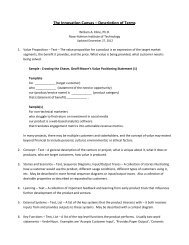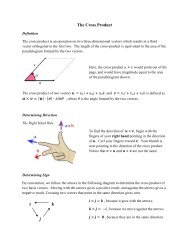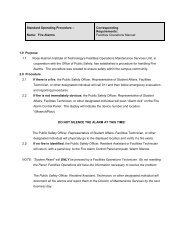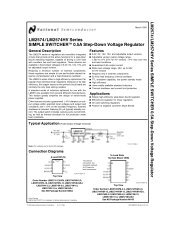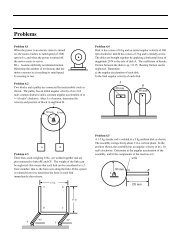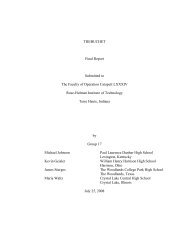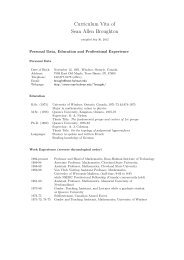21 Photosynthesis (Carbon Assimilation) The light ... - Rose-Hulman
21 Photosynthesis (Carbon Assimilation) The light ... - Rose-Hulman
21 Photosynthesis (Carbon Assimilation) The light ... - Rose-Hulman
You also want an ePaper? Increase the reach of your titles
YUMPU automatically turns print PDFs into web optimized ePapers that Google loves.
principle, one complete oxygen-evolving <strong>light</strong> reaction results in fixation of one<br />
molecule of carbon dioxide. In practice, however, some ATP and NADPH are used<br />
for other purposes, and therefore the <strong>light</strong> reactions and carbon assimilation<br />
reactions are not always stoichiometrically coupled.<br />
Side Note: <strong>The</strong> transketolase reaction<br />
<strong>The</strong> enzyme transketolase contains a thiamin pyrophosphate cofactor. As in most enzymes that use<br />
this cofactor, in transketolase, the thiamin pyrophosphate cofactor becomes transiently covalently<br />
modified during the reaction. In transketolase the two-carbon unit is removed from the ketose (in the<br />
example below, from xylulose-5-phosphate) and given to the aldose acceptor (in the example, to<br />
ribose-5-phosphate). <strong>The</strong> reaction generates an aldehyde in the remaining portion of the donor<br />
molecule, and maintains the ketone originally present in the transferred two-carbon unit.<br />
H 2 C<br />
OH<br />
H<br />
O<br />
C<br />
O<br />
O<br />
P<br />
O<br />
O<br />
H<br />
H<br />
H<br />
O<br />
C<br />
C<br />
C<br />
C<br />
CH 2<br />
Ribose-<br />
5-phosphate<br />
OH<br />
OH<br />
OH<br />
+<br />
O<br />
O<br />
P<br />
O<br />
O<br />
HO<br />
H<br />
O<br />
H 2 C<br />
Xylulose-<br />
5-phosphate<br />
C<br />
C<br />
C<br />
CH 2<br />
OH<br />
H<br />
OH<br />
Transketolase<br />
[TPP]<br />
O<br />
O<br />
P<br />
O<br />
HO<br />
H<br />
H<br />
H<br />
O<br />
C<br />
C<br />
C<br />
C<br />
CH 2<br />
H<br />
OH<br />
OH<br />
OH<br />
Sedoheptulose-<br />
7-phosphate<br />
+<br />
O<br />
O<br />
P<br />
O<br />
H<br />
O<br />
H<br />
C<br />
C<br />
CH 2<br />
OH<br />
O<br />
Glyceraldehyde-<br />
3-phosphate<br />
Utilization of assimilated carbon<br />
<strong>The</strong> excess trioses produced have several possible fates. <strong>The</strong>se fates must involve<br />
release of phosphate from the carbohydrate, otherwise phosphate becomes limiting.<br />
(Light allows carbon fixation, but does not increase the amount of phosphate<br />
present.)<br />
1) Starch production: Starch is an energy storage form of glucose. <strong>The</strong> starch<br />
produced and stored within the chloroplast acts as an energy source to maintain<br />
metabolism during the night.<br />
Starch is a mixture of amylose, a<br />
linear -1,4-glucose polymer and<br />
amylopectin, an -1,4-glucose<br />
polymer with -1,6 branches.<br />
Amylopectin differs from glycogen<br />
only in having fewer branch points.<br />
<strong>The</strong> diagram at right shows the<br />
structural features of the glucose<br />
polymers.<br />
HO<br />
OH<br />
OH<br />
HO<br />
CH 2<br />
OH<br />
O<br />
OH<br />
O<br />
2<br />
OHCH<br />
O<br />
OH<br />
O<br />
OH<br />
-1,6-Glucoside<br />
bond<br />
CH 2<br />
O<br />
OH<br />
HO<br />
O<br />
CH 2<br />
OH<br />
-1,4-Glucoside bond<br />
Starch (amylopectin)<br />
(-1,4-glucoside polymer<br />
with -1,6-glucoside<br />
branches)<br />
O<br />
OH<br />
HO<br />
O<br />
CH 2<br />
OH<br />
O<br />
OH<br />
n<br />
<strong>The</strong> starch synthetic system is generally similar to glycogen synthesis in animals.<br />
However, the starch synthase uses ADP-glucose rather than UDP-glucose as the<br />
Copyright © 2010-2011 by Mark Brandt, Ph.D.<br />
26





